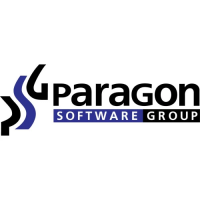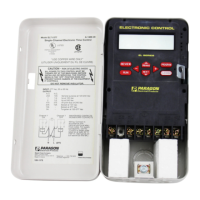Directions for Thermocouple Offsets:
1 From IdLE , press ENTER.
2 Press 0repeatedly until tCoS appears.
3 PressENTER. °FOS (or °COS )will appear,alternat
-
ingwiththecurrentthermocoupleoffset.(Factoryset
-
ting is 00.00).
4 Enter the new offset (e.g. 9005). Press ENTER. IdLE
will appear.
Toresetthermocoupleoffsetbackto0000,pressENTER,
0. RSEt will appear. Press ENTER.
Turning Off Error Codes (ErCd)
TheDTC1000uses errorcodes toalert youto firingprob
-
lems. In certain applications, it may be desirable to turn off
some of the error codes.
Forinstance, errorcode Err1 appearswhen temperature
rises slower than 12°F/12°C per hour. (In Ramp-Hold, the
temperature is also below the programmed temperature.)
Err1 mayinterfere when thedoorofthe kilnis opened to re
-
move certain materials, such as enameled pieces or heat
treated steel.
“Error Codes” ErCd , when set to OFF, turns off error
codes Err1 , Err2 , Err3 and Err4 . (See page 18 for a dis
-
cussion of these error codes.)
During the last 250°F/139°C of a Cone-Fire program,
the Err1 code will become active again even when
ErCd is turned off.
Setting Error Codes ON or OFF
1 Press ENTER from IdLE .
2 Press 0repeatedly until ErCd appears.
3 Press ENTER. On or OFF will appear. Press 1 to
change this setting.
4 Press ENTER. CPL will appear,followed by tempera
-
ture and IdLE .
RSEt (from OPTIONS key) can turn on error codes.
Trouble-Shooting & Maintenance
Furnace or Kiln Wiring Diagram
Your wiring diagram will show you how the controller, re-
lays, transformer and heating elements are connected. It will
aid you intracking downproblems. Ifyou need areplacement
diagram, call us.
Protecting the Controller From Static
Static electricity can damage the controller. Before han-
dling the board, touch a grounded object. When shipping the
controllerforrepairs,donotpackinbubblewraporstyrofoam
peanuts.Thesematerialscanbuildupastaticcharge.Instead,
use anti-static foam or even newspaper.
Element Glow Test: A Quick Test
Of Elements and Relays
1 The kiln should be empty. Close the lid or door.
2 In Ramp-Hold, fire at a rate of 9999 to 500°F/260°C.
While the kiln is firing, study your kiln’s wiring dia
-
gram.Itwillshowwhichelementsarewiredtoeachre
-
lay.
3 Ataround400°F/204°C,carefullyliftthelidoropenthe
door slightly until you can see the glowing elements.
CAUTION: Use a protective glove. Keep your face
well away from the firingchamber. Donot reach inside
the chamber. DO NOT TOUCH THE ELEMENTS
WITHANYTHING.Liftthelidforonlyamoment,then
close it.
Thecenterelementsinmost7,8,10and12 sidedkilnswill
notglowbrightly,butthereshouldbeafaintredness.Itmaybe
easier to see the elements by turning off the room lights.
Test result: All the elements for one relay remain dark.
The relay is probably defective.
Test result: One element remains dark, others glow.
Ifmorethan oneelement iswired tothe relay,thedarkele-
mentisprobablyburnedout.Theproblemisnottherelay.
Oncompletionoffiring,thedisplaywillshowfiringtimein
hours/minutes.Firingtimewillhelpyouoryourrepairtechni-
cian determine if the kiln is firing fast enough.
How to Remove Controller
SWITCH BOX WARNING:
UNPLUG kiln or furnace be
-
fore opening switch box or re
-
moving faceplate. Touching a
live connection inside switch
box could be fatal. Kiln must
be unplugged anytime switch
box is removed from kiln.
UNPLUG the kiln (or TnF
II).Removethefourscrewshold
-
ing the faceplate to the switch
box.
TnFII owners:UNPLUGthe TnF IIfrom the walloutlet
whenever these instructions say to unplug the kiln.
Removing Controller for Voltmeter Check
When checking controller board with a voltmeter
multitester, remove only controller faceplate and not the kiln
switch box. Before removing controller board, UNPLUG the
kiln.Thenletthecontrollerboardhangontheswitchboxwith
the back of the board facing you. Plug the kiln back in before
testingtheboard.Thereasontounplugthekilnbeforeyoure
-
15

